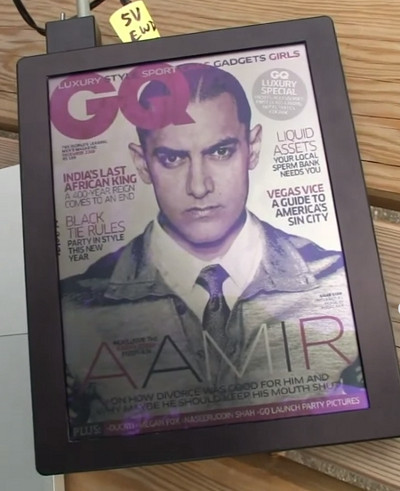Over the past year tablet displays have greatly improved in terms of screen resolution and pixel density, but two areas that still need improving are outdoor readability and energy efficiency.
Today’s tablets with LCD screens are very bright and easy to read indoors, but outside and in areas with bright lighting annoying reflections and glare consume the screen, and colors don’t appear nearly as bright. Battery life is typically 10 hours or less for most tablets, and the screen is the main source of power drain.
By contrast ebook readers like the Kindle and Kobo have E Ink screens that are very easy to read in direct sunlight, and they have batteries that last for weeks, sometimes months. The main disadvantage with E Ink, of course, is the slow refresh rate of the screen and the fact it is best suited for black-and-white applications. Color E Ink has been in production for a few years now, but has yet to go mainstream, mainly because of high costs and the fact that colors appear dull and washed-out when not under bright light.
Given the limitations of electronic ink and LCD, it’s more likely that an alternative type of display technology will take the lead in producing energy-efficient color displays that are readable in direct sunlight.
One potential candidate is electrowetting displays. Electrowetting is an interesting technology that uses electricity to alter the “wetness” of a film of oil applied to the screen to make it change shape. In its default state the oil is flat and opaque so no light can get through. Add some voltage to the mix and the oil forms into tight little beads that allow light to pass through. Colors are then determined by controlling how much light passes through the sub-pixels with colored filters for red, blue, and green.
One of the main advantages of electrowetting displays is that they require less power. They can be backlit, frontlit, or have no internal light at all, much like E Ink. It is said that a backlit electrowetting display can achieve double and maybe even triple the battery life compared to current devices with LCD screens.
Another advantage with electrowetting displays is they are visible in bright sunlight like E Ink because no polarizing filters are required. In fact the brighter the light on the display the better it looks.
The big question is when will electrowetting displays hit the market? Right now there are two companies trying to get these new type of displays into your hands. Liquavista was purchased by Samsung a couple of years back and is the most likely candidate to get electrowetting displays onto the market first. Another contender is Gamma Dynamics, who is working on an adhesive film that manufacturers could use to laminate onto a backplane to produce ereader and tablets displays, much like how E Ink is produced now.


Of all of the color e-paper concepts, this one seems the most solid. The advantages of electrowetting are the same as Mirasol or Triton technologies: no front or back light is required to see the screen, greatly reducing the power consumption. In side-by side shots, images on electrowetting and Mirasol look FAR superior to those Triton displays, and the electrowetting displays outperform the PixelQi screens. Electrowetting displays offer superior viewing angles and refresh rates, as well. I think the biggest draw of electrowetting, though, is that manufacturing of these displays can be done on virtually the same infrastructure as is used on LCD screens. Manufacturers won’t need to change a whole lot in their factories. This should positively affect pricing. But, pricing is the problem… everything depends on how much these cost when they’re consumer-ready.
I’m just hoping it turns out to be better than Pixel Qi. I got suckered into getting the Notion Ink Adam because of the Pixel Qi screen and it turned out to be majorly disappointing. Even when you are looking at the screen head-on the viewing are terrible, and it’s hardly better outside than an iPad and colors are so dim it could be mistaken as monochromatic. Not to mention the battery life increase is nominal. It only adds like 2 hours with the backlight off completely.
From what I’ve read, the screen is substantially superior to Pixel Qi. Viewing angles are reported to be impressive, as are refresh rates. The screen is reflective, so there’s no back light. As such, colors are a bit more washed out than from an LCD screen. Without a frontlight employed, it’s reported to have noticeably increased battery life versus LCD. It seems impressive enough, provided they can keep it thin and relatively inexpensive.
Well Electrowetting displays may be promising but the tag certainly isn’t: ‘Electrowetting’ elicits the prospect of incontinent circuitry. Perhaps Samsung’s marketing department will look into it.
I guess we won’t be seeing these Samsung screens in any iPads anytime soon…
You never know… Samsung and Apple may be distancing themselves from each other, but they’re still friendly enough (and business savvy enough) to know that it makes sense to sell to the competition or use their products, as appropriate. If the new iPad is the biggest selling tablet, I doubt Samsung will cut off its nose to spite its face and not distribute these screens to other companies, including Apple… at a premium, of course. Likewise, Apple isn’t stubborn enough to not use the technology, should it be proven viable enough and solid enough for their quality control standards. Really, the QA is the likeliest reason we won’t see these in an iPad… they just might not look good enough to satisfy Apple’s higher-ups.
I don’t know about Apple and quality – Iphone is rather crappy compared to Galaxy eg.